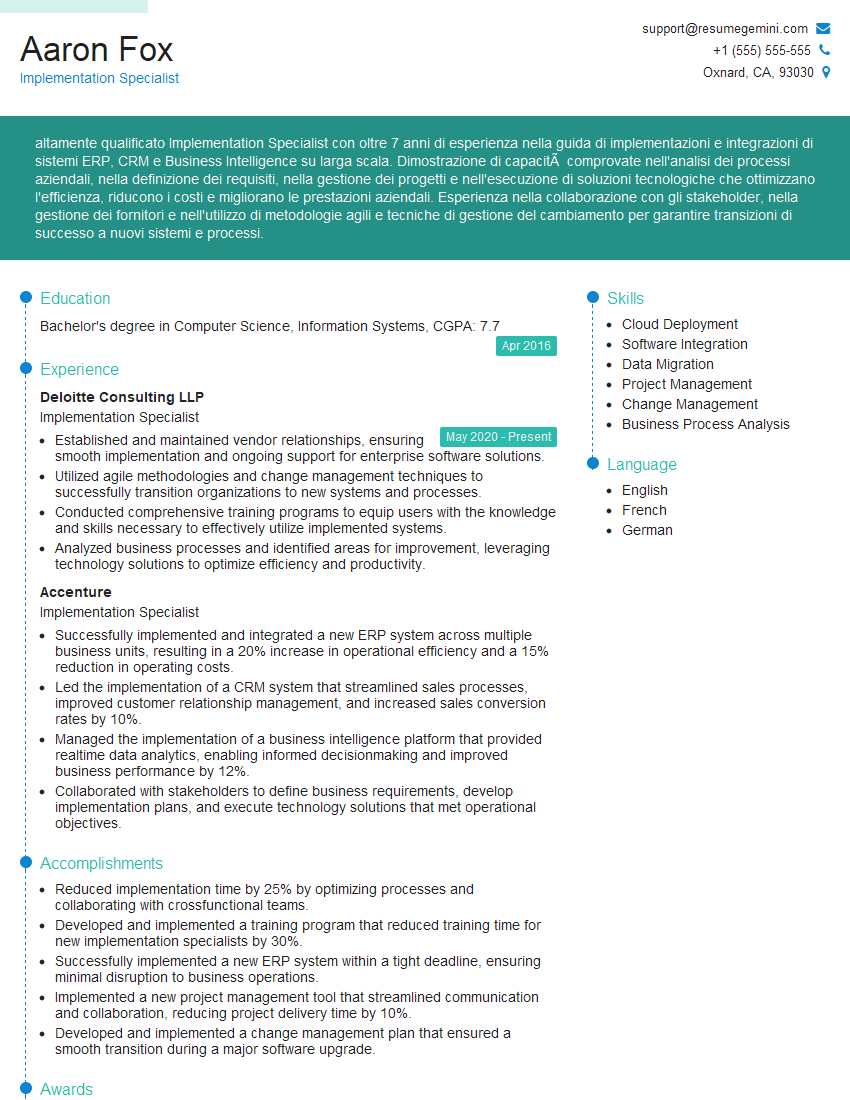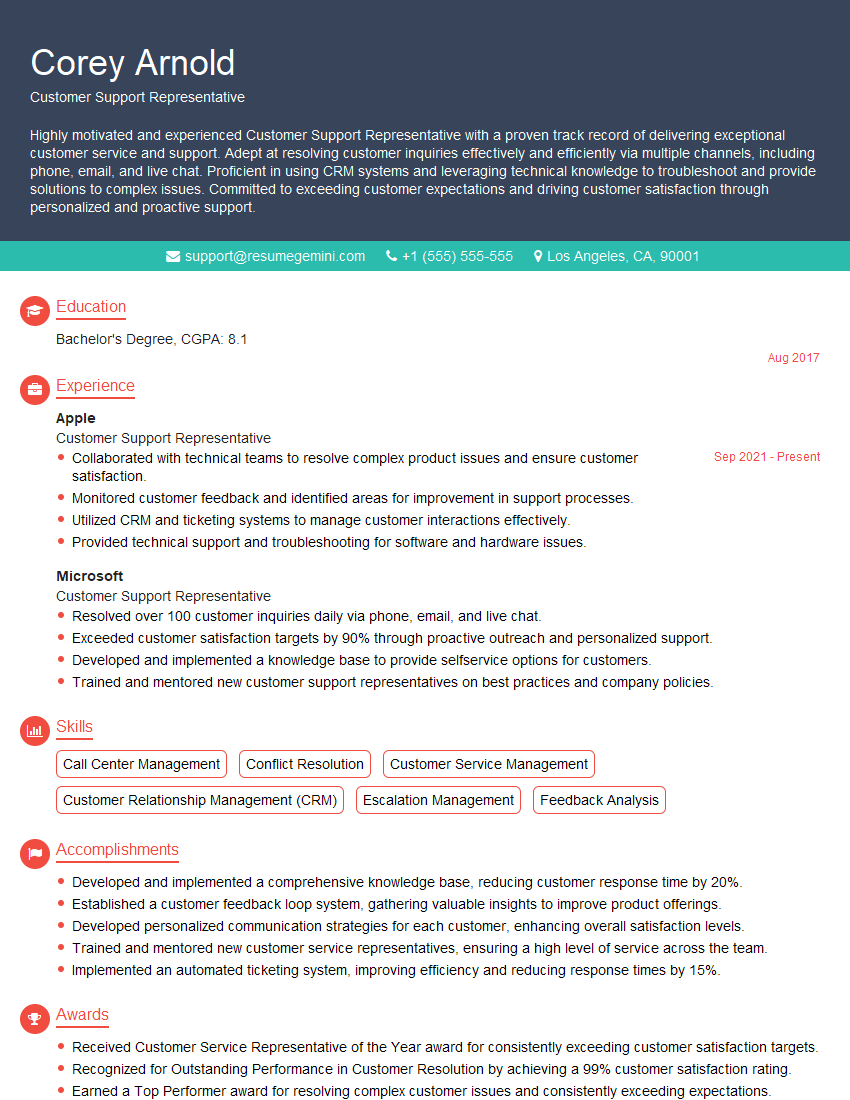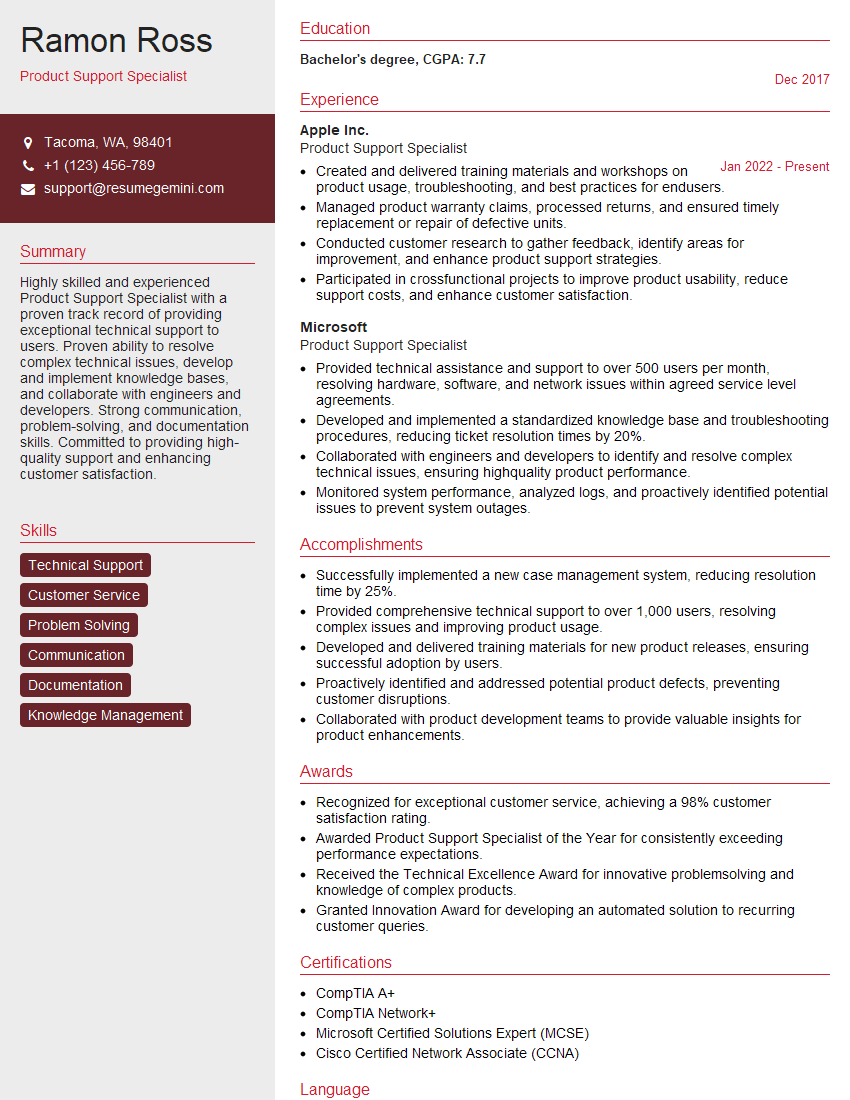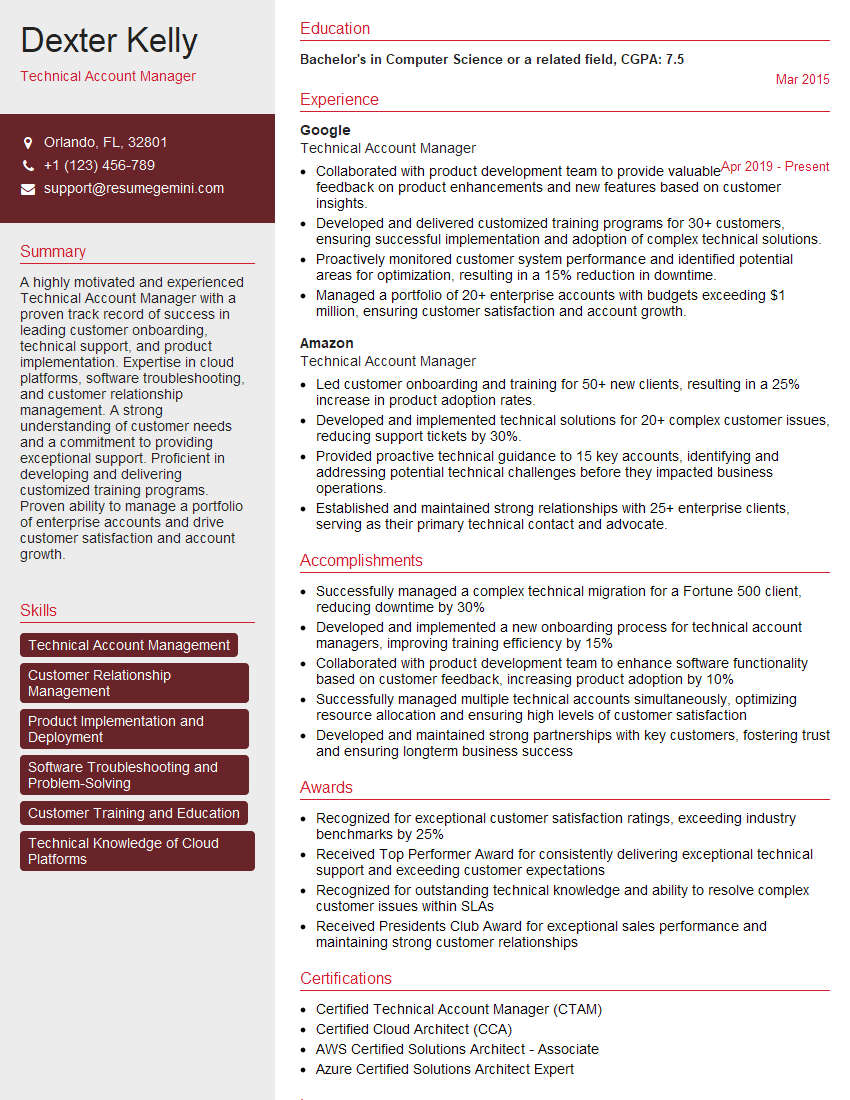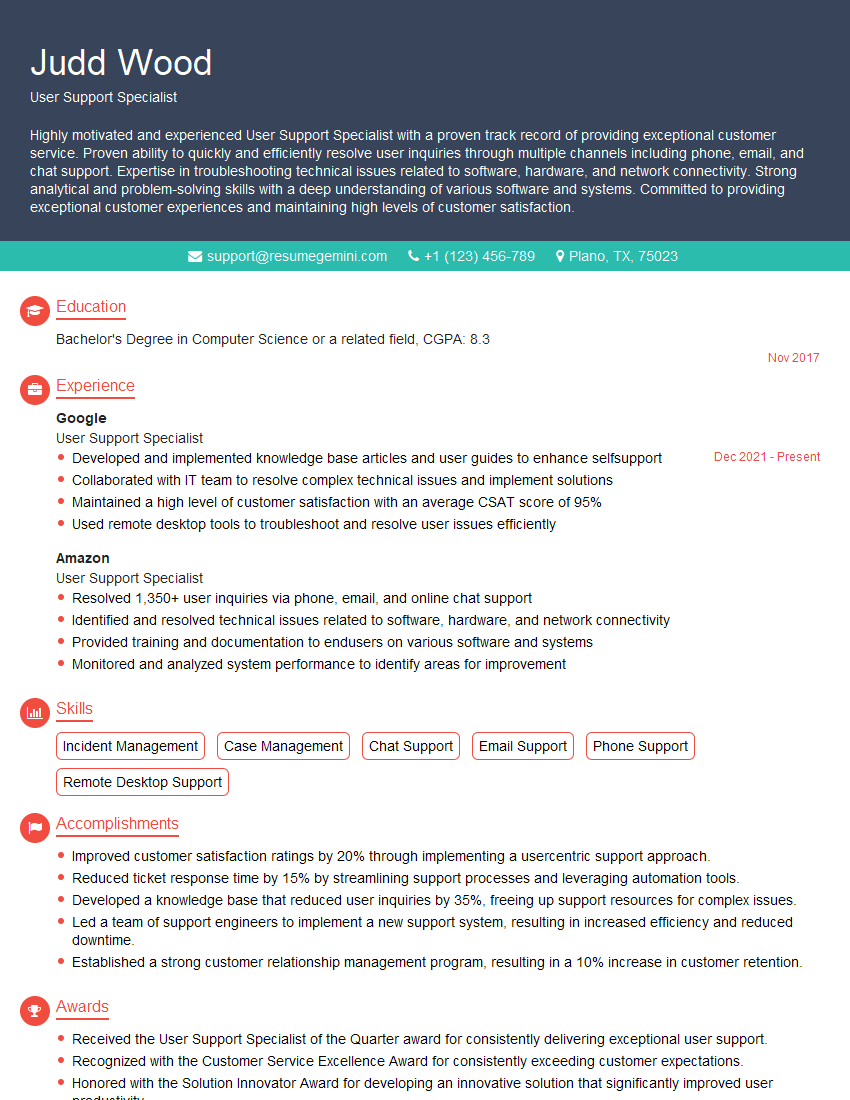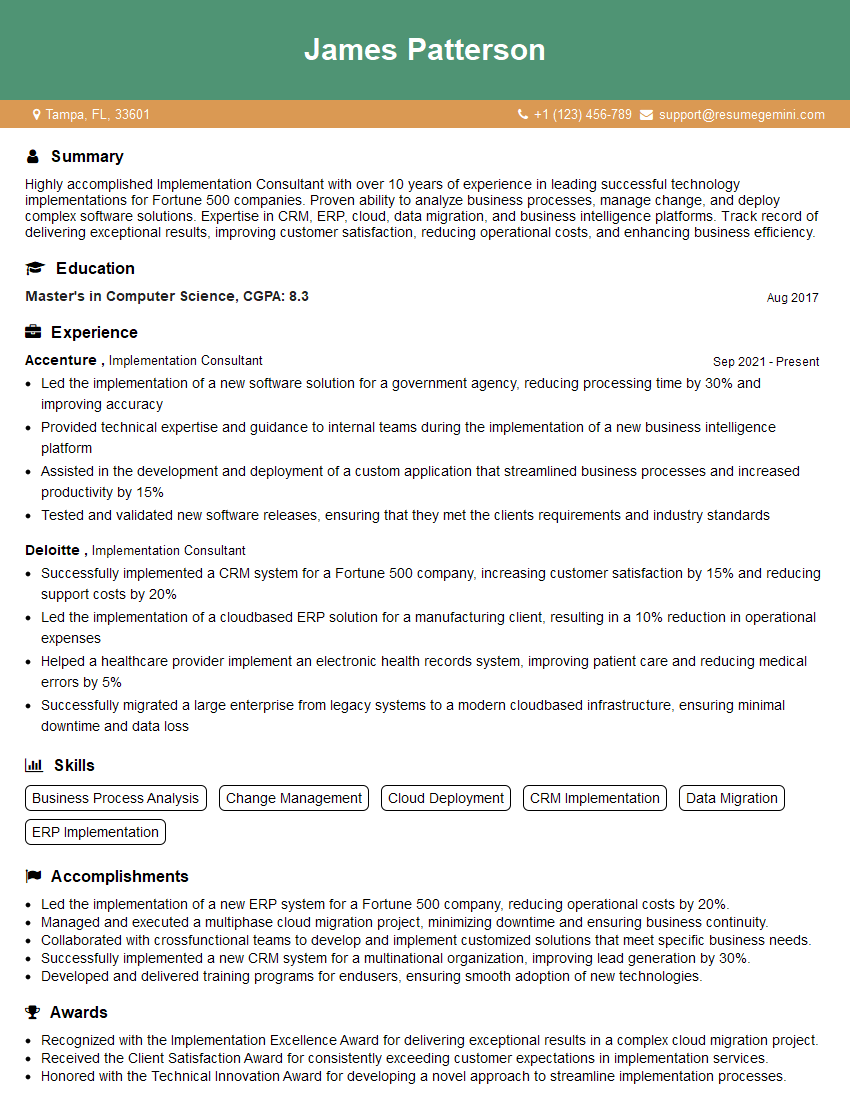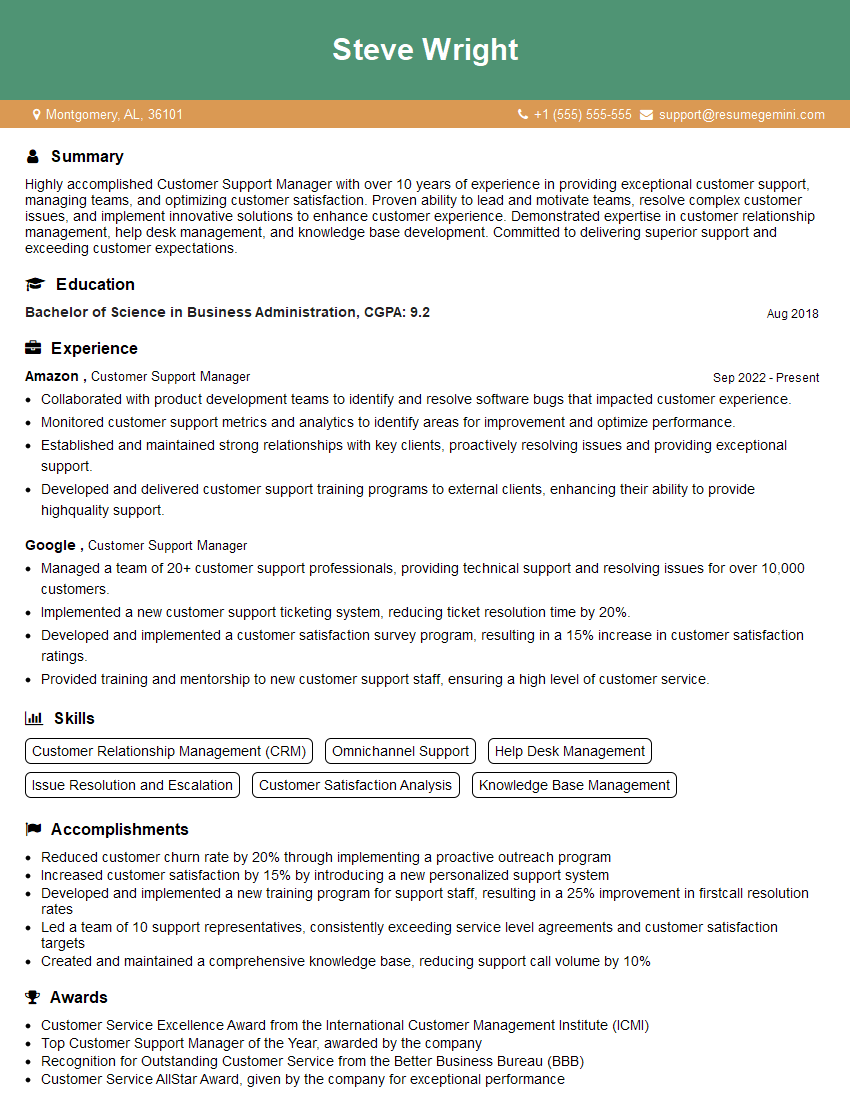Interviews are more than just a Q&A session—they’re a chance to prove your worth. This blog dives into essential User Support and Onboarding interview questions and expert tips to help you align your answers with what hiring managers are looking for. Start preparing to shine!
Questions Asked in User Support and Onboarding Interview
Q 1. Explain your experience with different customer support ticketing systems.
Throughout my career, I’ve gained extensive experience with various customer support ticketing systems, each with its own strengths and weaknesses. I’ve worked with systems ranging from simple, self-hosted solutions like osTicket to sophisticated, cloud-based platforms such as Zendesk, Freshdesk, and Salesforce Service Cloud. My experience encompasses configuring workflows, customizing ticket fields, integrating with other tools (like CRMs), and managing user access permissions. For example, in my previous role at Company X, we transitioned from a legacy system to Zendesk, a move that significantly improved our ticket management efficiency and reporting capabilities. The implementation involved thorough planning, user training, and data migration, all of which I played a key role in. I also have experience with internal tools designed for specific project management or technical support needs, showcasing my adaptability across various systems.
Q 2. Describe your process for onboarding new users to a software application.
My onboarding process for new software users is structured around a phased approach focused on gradual skill acquisition and consistent support. It typically starts with a welcome email containing essential login information and a link to a dedicated onboarding portal. This portal might include video tutorials, interactive walkthroughs, and frequently asked questions. Next, we offer a live, introductory webinar or a personalized one-on-one session for deeper engagement, addressing specific user needs and answering questions in real-time. This is followed by a series of follow-up emails with tips, resources, and encouragement. We also utilize in-app guidance and tooltips, providing contextual help when users are actively using the software. Finally, ongoing support is provided through various channels (email, chat, phone) to address any ongoing issues or questions. I consider measuring user engagement throughout the onboarding process to be vital. This helps identify areas for improvement and ensure users get the support they need to succeed.
Q 3. How do you handle escalated customer issues?
Handling escalated customer issues requires a systematic approach that balances empathy and efficiency. First, I acknowledge the user’s frustration and validate their concerns. Then, I systematically gather information to fully understand the problem. This includes reviewing the existing ticket history, requesting screenshots or logs, and potentially asking clarifying questions. Next, I attempt to resolve the issue using my knowledge base and troubleshooting skills. If I can’t resolve it independently, I escalate it to the appropriate internal team (e.g., engineering, development) providing clear and concise documentation of the problem, steps already taken, and the user’s impact. Throughout the process, I keep the user informed of my progress, managing their expectations and ensuring timely communication. If the resolution takes longer than expected, I provide regular updates to avoid any further frustration.
Q 4. What metrics do you use to measure the success of your onboarding program?
Measuring the success of our onboarding program relies on a combination of quantitative and qualitative metrics. Quantitative metrics include the completion rate of onboarding modules, the time it takes users to achieve key milestones (e.g., completing their first task), and the number of support tickets submitted during the onboarding period (lower numbers are better!). Qualitative metrics involve gathering feedback through surveys, user interviews, or analyzing user comments. Analyzing user engagement data such as time spent in the application and frequency of usage also provides valuable insights. We use these metrics to identify bottlenecks, refine our process, and ultimately improve the user experience. For example, a low completion rate of a specific module might indicate the need for simpler instructions or more engaging content.
Q 5. How do you prioritize multiple support requests simultaneously?
Prioritizing multiple support requests involves a blend of urgency and impact. I utilize a system that considers the severity of the issue (critical, high, medium, low), the impact on the user (business-critical, significant inconvenience, minor inconvenience), and the time sensitivity of the request. I often employ a ticketing system that allows for custom prioritization levels. For instance, a critical issue causing a complete system outage for a key user will take precedence over a low-priority question about a minor feature. I use various methods such as color-coding tickets and using labels in my ticketing system to help me quickly identify and act on high-priority issues. Transparency with users is also important; if a request isn’t immediately addressed, I let them know the expected wait time and why.
Q 6. Describe a time you had to troubleshoot a complex technical issue for a user.
One time, a user reported a seemingly simple issue: their data wasn’t syncing correctly. After initial troubleshooting steps, it became clear that this was more complex than initially thought. Through careful questioning and remote access (with the user’s explicit permission), I discovered a conflict between their local system settings and a recent software update. This involved examining log files, checking system configurations, and carefully guiding the user through complex configurations and restarts. The resolution required a deep understanding of both the software and the user’s system environment. Ultimately, we identified the root cause – a clash between the database version and their operating system’s security settings – and resolved the issue by adjusting the configuration. This experience reinforced the importance of patient, methodical troubleshooting and clear communication with the user throughout the process. I documented the issue and solution meticulously, adding the knowledge gained to our internal knowledge base for future reference.
Q 7. What strategies do you use to improve user engagement and satisfaction?
Improving user engagement and satisfaction is a continuous process. Key strategies I employ include proactive communication, personalized support, and a commitment to continuous improvement. Proactive communication means anticipating potential issues and providing users with helpful resources before they encounter problems. This might involve sending out regular newsletters, creating helpful FAQs, or updating our in-app tutorials. Personalized support means adapting my approach to the individual needs of the user, whether it’s providing tailored instructions or offering follow-up support. Continuous improvement involves regularly analyzing user feedback, tracking key metrics (like Net Promoter Score), and iteratively improving our processes based on what we learn. This might include streamlining our onboarding process, updating our help center content, or implementing new features based on user requests.
Q 8. How do you create and maintain a knowledge base?
Creating and maintaining a robust knowledge base is crucial for effective user support. It acts as a central repository of information, reducing the need for repetitive support interactions and empowering users to solve problems independently. My approach involves a multi-stage process:
- Content Planning: I begin by identifying the most frequently asked questions (FAQs) and common user pain points. This often involves analyzing support tickets, surveys, and user feedback. For example, if we see a surge in questions about a specific feature, that becomes a priority for knowledge base entry.
- Content Creation: I then create clear, concise, and accurate articles. Each article should address a single topic, using simple language, avoiding jargon, and including visual aids such as screenshots or videos where appropriate. I always strive to use a conversational tone to make the information engaging and easily digestible.
- Organization and Structure: The knowledge base needs a logical structure for easy navigation. I typically use categories and subcategories to organize articles, making it simple for users to find the information they need. A robust search functionality is also essential.
- Quality Assurance: Regular review and updates are vital. I schedule periodic reviews to ensure accuracy and relevance. I also incorporate user feedback and suggestions to continuously improve the content. For instance, if users report an article is unclear, I revise it based on their comments.
- Maintenance and Updates: As the product evolves, so too must the knowledge base. I actively monitor updates and product releases, ensuring the knowledge base remains current and accurate.
Using a platform like Zendesk Guide or a similar tool significantly streamlines this process, providing features for version control, collaboration, and analytics to track knowledge base usage.
Q 9. What is your experience with remote support tools?
I have extensive experience with a range of remote support tools, including:
- Screen Sharing Software: Tools like TeamViewer, Zoom, and GoToMeeting allow me to guide users through tasks on their computers in real-time, efficiently resolving technical issues. For example, I can remotely assist a user in configuring their network settings.
- Remote Control Software: In certain situations, remote control is necessary for more in-depth troubleshooting. I am proficient in using tools that allow me to take full control of a user’s system to diagnose and fix problems more quickly.
- Chat and Messaging Platforms: I’m skilled at using platforms like Slack, Intercom, and Zendesk Chat for providing quick responses to user queries and providing preliminary support.
- Ticketing Systems: I’m adept at using ticketing systems like Zendesk and Jira Service Desk to track, manage, and prioritize support requests, ensuring efficient resolution and follow-up.
My experience extends beyond simply using these tools; I understand how to select the most appropriate tool for a given situation, considering factors such as the user’s technical proficiency and the complexity of the issue. I also understand the importance of maintaining user privacy and security when utilizing remote access capabilities.
Q 10. How do you adapt your communication style to different user personalities?
Adapting communication style is crucial for effective user support. Understanding and responding to different personality types ensures a positive user experience. I achieve this through active listening and observation:
- Empathetic and Patient Approach: For frustrated or anxious users, a calm, patient, and empathetic approach is vital. I actively listen to their concerns and validate their feelings before offering solutions. For example, I might say, “I understand this is frustrating, let’s work together to resolve this.”
- Direct and Concise Communication: For users who prefer efficiency, I communicate clearly and concisely, directly addressing their questions without unnecessary details. I might use bullet points or numbered lists to present information effectively.
- Technical vs. Non-Technical Language: I adjust my language based on the user’s technical expertise. With non-technical users, I use simple language and avoid jargon. Conversely, I can use more technical terms with users who are familiar with the terminology.
- Visual Aids: Visual aids like screenshots or short videos can be helpful for all user types, simplifying complex instructions or illustrating technical concepts.
By closely observing user communication styles – whether through written communication or verbal interactions – I tailor my approach accordingly, fostering better engagement and understanding.
Q 11. How do you handle negative customer feedback?
Handling negative customer feedback requires a professional and empathetic approach. My strategy involves:
- Active Listening and Acknowledgement: I start by acknowledging the user’s frustration and validating their feelings. I carefully listen to their concerns without interrupting, allowing them to fully express their dissatisfaction.
- Empathy and Apology: If appropriate, I offer a sincere apology for the negative experience. Even if the issue wasn’t directly caused by a fault of the company, acknowledging their frustration shows respect and understanding.
- Problem Solving and Solution Focused Approach: I shift the focus to finding a solution. This might involve troubleshooting the problem, offering compensation, or explaining the steps taken to prevent similar issues from occurring.
- Follow-up: I always follow up with the user to confirm that the issue has been resolved to their satisfaction. This demonstrates a commitment to customer care and shows that their feedback is valued.
- Internal Feedback: I use the feedback as an opportunity to identify areas for improvement in our product or service. This might involve reporting the issue to the relevant team for investigation and resolution.
For example, if a user complains about a slow loading time on the website, I would acknowledge their frustration, apologize for the inconvenience, and explain what steps are being taken to improve the website’s performance. I might offer them a temporary alternative or a small compensation, and follow up later to check their experience.
Q 12. Describe your experience with training materials development.
I have significant experience in developing training materials, focusing on creating engaging and effective content. My approach centers around understanding the target audience and their learning styles:
- Needs Assessment: Before beginning, I thoroughly assess the audience’s existing knowledge, learning goals, and preferred learning styles. This involves surveys, interviews, and observation if possible.
- Content Development: I create materials that are clear, concise, and easy to understand, using a variety of formats including videos, interactive tutorials, written guides, and presentations. For instance, a complex process can be broken down into smaller, easily digestible chunks using short videos combined with checklists.
- Multimedia Integration: To enhance engagement, I incorporate multimedia elements such as images, videos, and interactive exercises. Visual aids greatly improve comprehension, particularly for complex technical processes.
- Testing and Iteration: Before final release, I thoroughly test the training materials with a small group, gathering feedback and iterating on the content based on their insights.
- Accessibility: I ensure the materials are accessible to all users, following accessibility guidelines (WCAG) to make them usable for individuals with disabilities.
For instance, when developing onboarding materials for a new software, I would create short video tutorials demonstrating key features, a quick-start guide, and a FAQ document. This multi-faceted approach addresses diverse learning styles and ensures effective knowledge transfer.
Q 13. What are some common challenges in user onboarding, and how have you overcome them?
Common challenges in user onboarding often stem from information overload, lack of engagement, and insufficient support. Here are some I’ve encountered and how I’ve overcome them:
- Information Overload: New users can be overwhelmed by too much information at once. My solution is to break down the onboarding process into smaller, manageable steps, using a phased approach. For instance, focus on core features first, then gradually introduce more advanced functionalities.
- Lack of Engagement: Boring or ineffective training materials can lead to low engagement. To address this, I incorporate interactive elements, gamification, and personalized feedback to keep users interested and motivated. Interactive tutorials, quizzes, and progress trackers all help maintain user engagement.
- Insufficient Support: Lack of readily available support can leave users feeling lost and frustrated. I create comprehensive FAQs, support documentation, and in-app help resources to ensure users have immediate access to assistance when needed. A robust knowledge base and readily available chat support are crucial here.
- Lack of Clear Goals: Users need to understand the value proposition and what they can achieve with the product. Clearly defining the value proposition and showcasing success stories can help demonstrate the product’s benefits and encourage user engagement.
By proactively addressing these challenges and implementing user-centered design principles, I improve onboarding success rates and increase user satisfaction.
Q 14. How do you measure the effectiveness of your training programs?
Measuring the effectiveness of training programs is crucial for continuous improvement. My approach involves a combination of qualitative and quantitative methods:
- Completion Rates: Tracking the percentage of users completing the training program provides a basic measure of engagement.
- Time-to-Proficiency: Measuring the time it takes users to become proficient with the product or service offers insights into the training’s effectiveness.
- User Feedback: Surveys, feedback forms, and user interviews provide valuable qualitative data on user satisfaction and areas for improvement.
- Knowledge Assessments: Pre- and post-training assessments can measure the increase in user knowledge and understanding.
- Performance Metrics: Tracking key performance indicators (KPIs) related to user behavior, such as task completion rates or error rates, can indicate whether the training has led to improved performance. For instance, if the training aims to reduce support tickets, a decrease in ticket volume would be a positive indicator.
- Support Ticket Analysis: A reduction in support tickets related to the topics covered in the training suggests effective knowledge transfer.
By analyzing these metrics, I can identify areas of strength and weakness in the training program and make data-driven improvements to enhance its effectiveness.
Q 15. Describe your experience with different customer relationship management (CRM) systems.
My experience with CRM systems spans several platforms, including Salesforce, HubSpot, and Zoho CRM. I’m proficient in using these systems to manage customer interactions, track support tickets, analyze customer data, and personalize communication. For example, in a previous role using Salesforce, I leveraged its reporting features to identify top customer pain points, enabling proactive support and improvements to our product. This involved creating custom reports to track ticket resolution times, customer satisfaction scores (CSAT), and the frequency of specific issues. My understanding extends beyond simply data entry; I’m skilled in customizing workflows, configuring automation rules, and integrating CRM data with other business intelligence tools to gain a holistic view of our customer base and optimize our support strategy. In another instance using HubSpot, I utilized the contact properties and segmentation features to create targeted email campaigns for onboarding new users based on their specific needs and roles. This helped significantly improve user engagement and satisfaction.
Career Expert Tips:
- Ace those interviews! Prepare effectively by reviewing the Top 50 Most Common Interview Questions on ResumeGemini.
- Navigate your job search with confidence! Explore a wide range of Career Tips on ResumeGemini. Learn about common challenges and recommendations to overcome them.
- Craft the perfect resume! Master the Art of Resume Writing with ResumeGemini’s guide. Showcase your unique qualifications and achievements effectively.
- Don’t miss out on holiday savings! Build your dream resume with ResumeGemini’s ATS optimized templates.
Q 16. How familiar are you with different help desk software (e.g., Zendesk, Jira Service Desk)?
I possess extensive experience with various help desk software solutions. My expertise includes Zendesk, Jira Service Desk, and Freshdesk. I understand their strengths and weaknesses, and I can adapt my workflow to the specific features of each platform. In Zendesk, I’ve managed large volumes of tickets using its robust automation and reporting tools, optimizing our team’s efficiency. For example, I’ve set up triggers to automatically assign tickets based on keywords, reducing response times and ensuring that the right team member handles each issue. With Jira Service Desk, I’ve integrated it with our development process, enabling seamless communication between support and engineering teams, thereby accelerating issue resolution. This integration has been critical for tracking bugs and feature requests. Freshdesk’s reporting and analytics features have allowed me to identify and quantify improvements in our support performance over time, measuring key metrics such as First Contact Resolution (FCR) and Customer Satisfaction (CSAT).
Q 17. How do you identify and resolve recurring user issues?
Identifying and resolving recurring user issues requires a systematic approach. First, I analyze help desk tickets and customer feedback to identify patterns and common themes. I use tools like Excel or dedicated reporting dashboards within the CRM or helpdesk to visualize trends. For example, if I notice a significant number of tickets related to a specific feature, I’ll investigate further to determine the root cause. This often involves direct user interaction through follow-up questions and remote sessions. Once the root cause is identified (e.g., poor documentation, a bug in the software, or a usability issue), I develop a solution. This might involve creating updated documentation, submitting a bug report to the development team, or suggesting UI/UX improvements. Finally, I monitor the impact of the solution and track whether the recurrence rate decreases significantly. A successful solution demonstrates a drop in the number of related support tickets and a positive shift in user feedback.
Q 18. What is your experience with A/B testing in the context of user onboarding?
My experience with A/B testing in user onboarding focuses on optimizing the user experience and improving key metrics such as activation rates and time-to-value. I’ve conducted A/B tests on various onboarding elements, such as welcome emails, tutorial design, and in-app guidance. For instance, I once tested two different welcome email designs: one with a concise overview and a clear call to action, and another with a longer, more detailed explanation. By tracking the click-through rates and user engagement metrics for both versions, we determined that the concise version significantly improved user activation. This involved using tools like Optimizely or VWO to create and manage the tests, ensuring statistical significance of the results. Successful A/B testing relies on clearly defining hypotheses, measuring the right metrics, and iterating based on data-driven insights. It’s important to test one variable at a time to avoid confounding factors.
Q 19. Describe your experience with user feedback collection and analysis.
Collecting and analyzing user feedback is a crucial aspect of my work. I employ various methods including in-app surveys, post-interaction surveys, user interviews, and community forums. For example, using in-app surveys, I’ve gathered feedback on specific features, while post-interaction surveys help gauge customer satisfaction after a support interaction. User interviews provide qualitative insights into user needs and pain points. Community forums are invaluable for understanding emerging trends and challenges. I analyze this feedback using qualitative and quantitative methods. Quantitative data (e.g., CSAT scores, Net Promoter Score (NPS)) provides a high-level overview, while qualitative data (e.g., open-ended survey responses, interview transcripts) offer rich contextual information. This combined approach allows me to gain a comprehensive understanding of user sentiment and identify areas for improvement. Data visualization tools like Tableau or Power BI are very helpful in representing this feedback effectively.
Q 20. How do you contribute to continuous improvement of support processes?
I contribute to continuous improvement of support processes through proactive identification of areas for optimization. This includes regular review of support metrics (e.g., ticket resolution time, customer satisfaction scores), analysis of user feedback, and brainstorming sessions with the support team. For example, I’ve implemented changes to our ticketing system based on data showing high ticket volumes for a particular issue, leading to reduced resolution times. I’ve also advocated for the introduction of new knowledge base articles to address frequently asked questions, thereby reducing the workload on the support team. Moreover, I actively participate in knowledge sharing and training within the team, ensuring everyone is up-to-date on best practices and new processes. By fostering a culture of continuous improvement, we can enhance the efficiency and effectiveness of our support operations and deliver an exceptional customer experience.
Q 21. Explain your approach to documenting support processes and procedures.
My approach to documenting support processes and procedures emphasizes clarity, accessibility, and ease of use. I utilize a combination of methods, including detailed written instructions, flowcharts, and video tutorials. For example, when documenting the process for resolving a specific technical issue, I’ll create a step-by-step guide with screenshots and clear explanations. Flowcharts visually represent the decision-making process involved in troubleshooting, and video tutorials offer a more dynamic and engaging way to demonstrate complex procedures. The documentation is stored in a centralized repository accessible to all support team members, and it’s regularly reviewed and updated to reflect any changes in processes or systems. This ensures that everyone has access to the most current and accurate information, leading to consistency in support delivery and a smoother onboarding process for new team members.
Q 22. How do you handle situations where you don’t have immediate answers to user questions?
Honesty and transparency are key when I don’t have an immediate answer. Instead of pretending to know something I don’t, I acknowledge the situation upfront. I might say something like, “That’s a great question! I don’t have the answer off the top of my head, but I’ll find out for you.”
My process then involves several steps:
- Research: I immediately begin researching the issue, consulting internal documentation, knowledge bases, or reaching out to colleagues with relevant expertise.
- Time Estimation: I provide the user with a realistic timeframe for when I expect to have an answer. For example, “I should have an answer for you within 30 minutes,” or “I’ll need to escalate this to our development team, and they’ll get back to you within 24 hours.”
- Follow-up: I consistently follow up with the user, providing updates and keeping them informed about my progress. This proactive communication helps build trust and reduces frustration.
- Documentation: Once I’ve solved the problem, I document the solution in our knowledge base to prevent similar issues from arising in the future. This also improves efficiency for myself and other support agents.
For example, if a user encountered a bug I wasn’t familiar with, I’d first try to replicate the bug. Then, I would search our internal bug tracking system to see if it’s already reported. If not, I’d report it, assigning it a priority based on its impact on users. I’d communicate all this to the user, providing updates as the bug got resolved.
Q 23. How do you build rapport with users?
Building rapport is crucial for effective user support. It involves creating a connection with the user based on empathy, understanding, and respect. I achieve this through several techniques:
- Active Listening: I pay close attention to what the user is saying, both verbally and nonverbally. This shows them that I value their input and understand their situation.
- Empathy: I try to understand the user’s perspective and feelings. I might say, “I understand this is frustrating,” or “I can see why this is a concern for you.”
- Clear and Concise Communication: I use simple, non-technical language whenever possible, tailoring my communication to the user’s level of technical understanding. I avoid jargon unless it’s absolutely necessary and then I clearly define any unfamiliar terms.
- Positive and Professional Demeanor: Maintaining a positive and professional attitude throughout the interaction creates a pleasant and reassuring experience for the user.
- Personalization: When appropriate, I use the user’s name and try to remember details from previous interactions. This shows I value the relationship and that I care about their experience.
For instance, if a user is clearly stressed about a technical issue, I’d acknowledge their frustration and calmly guide them through the solution, breaking it down into manageable steps. I might even offer to walk them through the process step by step via screen sharing if that’s comfortable for both of us.
Q 24. What are your preferred methods for gathering user feedback?
Gathering user feedback is essential for continuous improvement. I utilize a multi-faceted approach, combining quantitative and qualitative methods:
- Surveys: I use short, targeted surveys to gather feedback on specific aspects of the product or support experience. These can be integrated directly into the application or sent via email.
- In-app Feedback Forms: Embedding feedback forms directly within the application allows users to provide immediate feedback during their workflow. This provides context-rich data.
- User Interviews: Conducting user interviews provides valuable in-depth insights into users’ needs, pain points, and suggestions. These can be done individually or in small groups.
- Usability Testing: Observing users as they interact with the product helps identify areas for improvement in the user interface and overall user experience.
- Social Media Monitoring: Monitoring social media channels and online forums can reveal valuable feedback and insights into user sentiment.
- Support Ticket Analysis: Analyzing support tickets helps identify recurring problems and areas where users frequently require assistance. This directly reflects users’ struggles.
For instance, after launching a new feature, I might send out a short survey asking users about their experience with it. I’d also analyze the support tickets related to that feature to identify any common issues and areas where the documentation or user interface might need improvement.
Q 25. What is your experience with creating and delivering training webinars or online courses?
I have extensive experience in creating and delivering engaging training webinars and online courses. My approach centers around creating a structured, easily digestible learning experience.
My process involves:
- Needs Assessment: I first identify the specific learning objectives and the target audience’s existing knowledge level.
- Content Development: I create a detailed outline and develop the course content, using a variety of media such as video lectures, presentations, interactive exercises, and downloadable resources.
- Platform Selection: I choose an appropriate online learning platform based on the target audience, budget, and technical requirements. Popular choices include Zoom, Adobe Connect, or Learning Management Systems (LMS).
- Delivery and Engagement: During the webinar or course, I utilize interactive elements like polls, Q&A sessions, and group discussions to keep participants engaged.
- Assessment and Feedback: I incorporate assessments to evaluate participant understanding and collect feedback to improve future courses.
For example, I once developed a webinar series for a new software application. Each webinar focused on a specific module, with interactive quizzes and hands-on exercises to reinforce learning. I used a mix of screen recordings, live demonstrations, and downloadable guides to cater to various learning styles.
Q 26. Describe your experience with creating user manuals or other forms of technical documentation.
Creating user-friendly documentation is a passion of mine. I strive to produce clear, concise, and easily accessible manuals and guides.
My approach incorporates:
- Understanding the Audience: I tailor the language and complexity of the documentation to the target audience’s technical skills and knowledge.
- Clear Structure and Organization: I use a logical structure with clear headings, subheadings, and visual aids such as screenshots and diagrams to make the information easy to navigate.
- Consistent Formatting and Style: I maintain consistent formatting and style throughout the document to enhance readability.
- Search Functionality: For larger documents, I incorporate a robust search functionality to allow users to quickly find the information they need.
- Regular Updates: I regularly update the documentation to reflect changes in the software or system.
For instance, when creating a user manual for a complex software application, I would start by creating a detailed outline. I’d then write the content, breaking down complex tasks into simple steps. I’d include screenshots and diagrams to illustrate each step. Finally, I’d review and edit the document carefully before publishing it. After launch, I’d monitor user feedback to identify areas for improvement.
Q 27. How do you stay up-to-date on the latest technologies and best practices in user support?
Staying current in the dynamic field of user support requires continuous learning. My strategies include:
- Industry Publications and Blogs: I regularly read industry publications, blogs, and articles to stay informed about the latest trends and best practices.
- Conferences and Webinars: Attending conferences and webinars provides opportunities to network with other professionals and learn from experts.
- Online Courses and Certifications: I pursue online courses and certifications to enhance my skills and knowledge in areas such as customer relationship management (CRM), help desk software, and accessibility best practices.
- Professional Networks: I actively participate in online communities and professional organizations to exchange knowledge and collaborate with peers.
- Experimentation and Innovation: I am open to experimenting with new technologies and support strategies to improve efficiency and user satisfaction.
For example, I recently completed a course on improving accessibility in online support materials, which allowed me to incorporate best practices in my documentation and training materials.
Q 28. How do you measure the effectiveness of your user support efforts?
Measuring the effectiveness of user support efforts requires a data-driven approach. Key metrics I track include:
- Resolution Time: The average time it takes to resolve user issues. A shorter resolution time indicates improved efficiency.
- Customer Satisfaction (CSAT): Measuring user satisfaction through surveys and feedback helps gauge overall user happiness.
- First Contact Resolution (FCR): The percentage of issues resolved on the first contact. A higher FCR demonstrates improved efficiency and user experience.
- Net Promoter Score (NPS): Measuring the likelihood of users recommending the product or service to others. A higher NPS indicates strong customer loyalty.
- Ticket Volume and Trends: Tracking the volume and trends of support tickets helps identify recurring issues and areas for improvement. This reveals patterns and needs for proactive solutions.
- Agent Performance Metrics: Tracking agent performance metrics such as resolution time, customer satisfaction ratings, and efficiency helps identify areas for individual and team improvement.
By regularly monitoring and analyzing these metrics, I can identify areas for improvement in our support processes and strategies to enhance user experience and efficiency. For instance, if we see a consistently high resolution time for a specific issue, we might need to improve our documentation or training materials.
Key Topics to Learn for User Support and Onboarding Interview
- Understanding User Needs: Learn to effectively assess user technical skills and identify their specific needs and pain points. Consider how you would approach users with varying levels of technical proficiency.
- Onboarding Strategies: Explore different onboarding methodologies (e.g., self-service, guided walkthroughs, instructor-led training) and their effectiveness in different contexts. Think about how you’d tailor an onboarding experience to maximize user success.
- Troubleshooting & Problem Solving: Develop a systematic approach to diagnosing and resolving user issues. Practice breaking down complex problems into smaller, manageable steps. Consider common technical issues and how you would address them.
- Communication & Empathy: Master clear, concise, and empathetic communication techniques, both written and verbal. Practice actively listening to user concerns and providing solutions in a supportive manner.
- Ticketing Systems & Documentation: Familiarize yourself with common ticketing systems (e.g., Zendesk, Jira Service Desk) and the importance of maintaining accurate and up-to-date documentation for users and support staff.
- Metrics & Reporting: Understand how key performance indicators (KPIs) are used to measure the success of user support and onboarding programs. Consider how data informs improvements to the user experience.
- Software Proficiency: Highlight your proficiency in relevant software and tools. Be prepared to discuss your experience with any specific applications used in your target roles.
Next Steps
Mastering User Support and Onboarding skills opens doors to rewarding and impactful careers. These skills are highly valued across various industries and are crucial for fostering positive user experiences and driving business growth. To significantly increase your job prospects, crafting a strong, ATS-friendly resume is essential. ResumeGemini is a trusted resource that can help you build a professional and compelling resume tailored to highlight your unique skills and experiences. We provide examples of resumes specifically designed for User Support and Onboarding roles to help guide you. Invest the time to create a resume that showcases your capabilities—it’s a critical step in your job search journey.
Explore more articles
Users Rating of Our Blogs
Share Your Experience
We value your feedback! Please rate our content and share your thoughts (optional).
What Readers Say About Our Blog
Hi, I’m Jay, we have a few potential clients that are interested in your services, thought you might be a good fit. I’d love to talk about the details, when do you have time to talk?
Best,
Jay
Founder | CEO


